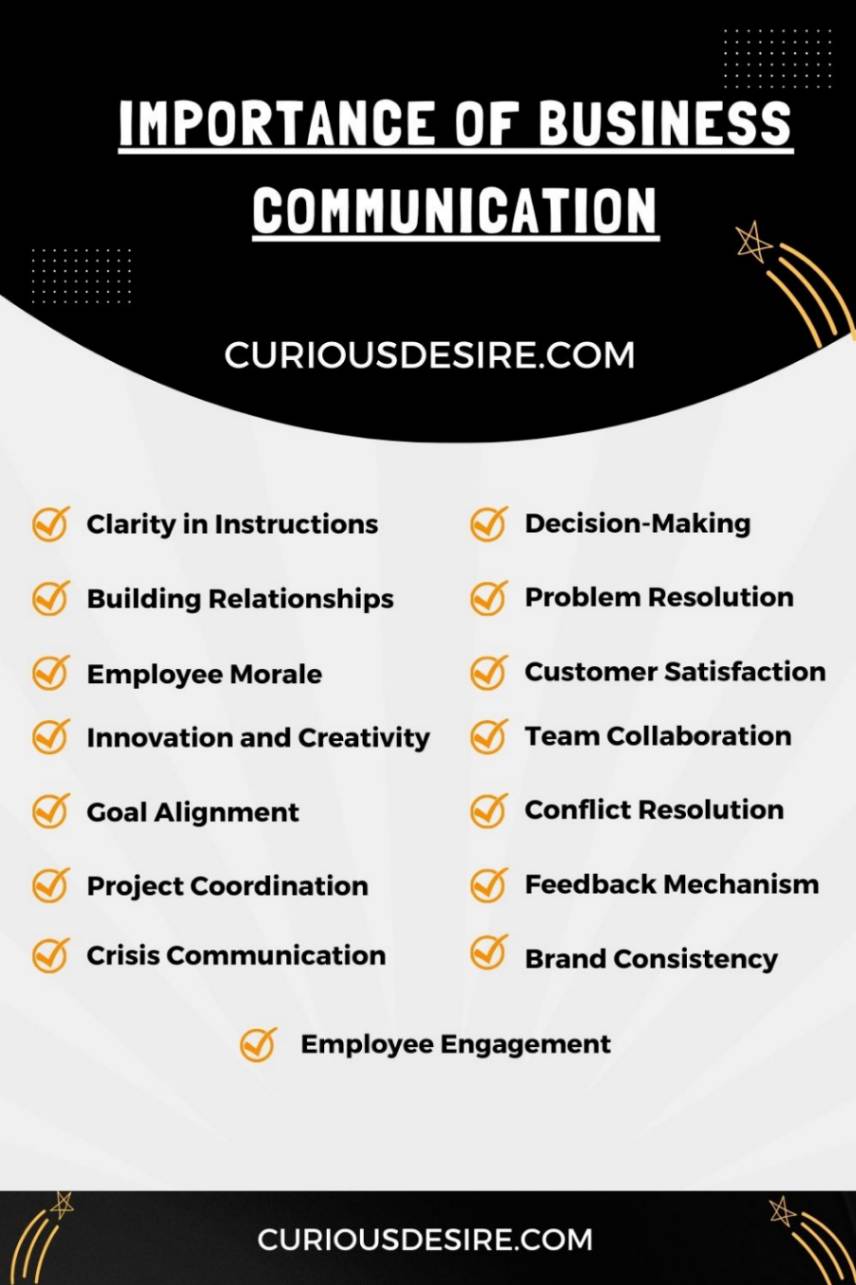Business communication is important because it’s like the language that helps everyone in a company understand and work together.
Imagine if we didn’t talk to each other about what needs to be done or share information – it would be like playing a team sport without passing the ball!
Clear communication helps us know what’s happening, what needs to be done, and how we can all work together to make the company successful.
It’s like the glue that holds a team together, making sure everyone is on the same page and moving in the right direction.
In this article, we’ll explore the different ways businesses communicate and why each of them is essential for a smoothly running operation.
Here are the 5 most common reasons for the importance of business communication:
- Clarity in Instructions
- Effective Decision-Making
- Building Strong Relationships
- Problem Resolution
- Employee Morale
1. Clarity in Instructions
Clear communication is important in business, like giving precise directions to a friend. Without clarity, tasks become ambiguous, leading to confusion and potential errors.
For instance, when managing a project, providing specific instructions like, “Complete the financial analysis section of the report by Friday and send it for review,” ensures everyone understands their role, reducing misunderstandings and enhancing project success.
To communicate effectively, use straightforward language, break down tasks, and encourage open dialogue for clarifications, promoting a more productive and error-free work environment.
2. Effective Decision-Making
In the business landscape, effective decision-making is like choosing the right path at a crossroads. It requires clear communication to gather relevant information and perspectives.
For instance, when a team discusses options for a new strategy, transparent communication ensures that each member comprehends the choices, enabling a well-informed decision.
To communicate for effective decision-making, encourage open dialogue, share data clearly, and consider diverse viewpoints, promoting an environment where decisions are based on a collective understanding.
3. Building Strong Relationships
Building strong relationships in business is like nurturing connections with friends; it requires trust, understanding, and clear communication.
For instance, when collaborating with clients or colleagues, transparent and honest communication builds trust and rapport. To communicate for relationship building, actively listen, express ideas clearly, and be responsive to others’ needs.
Regularly check in, show empathy, and address concerns quickly, creating a foundation for enduring and mutually beneficial professional relationships.
4. Employee Morale
Boosting employee morale in the workplace is comparable to nourishing a garden; it requires attention, care, and clear communication.
For instance, when recognizing achievements or addressing challenges, transparent communication helps employees feel valued and heard.
To communicate for enhanced employee morale, provide positive feedback, communicate organizational goals clearly, and promote a supportive environment where employees feel comfortable sharing their thoughts and ideas.
Regularly acknowledging contributions and addressing concerns builds a positive atmosphere, contributing to a high level of employee morale.
5. Problem Resolution
In business, addressing problems is like fixing glitches in a computer program; it demands clear communication to identify issues and implement solutions effectively.
For example, when a project faces challenges, open and transparent communication ensures that everyone involved understands the problem, promoting collaborative efforts to find viable solutions.
To communicate for effective problem resolution, encourage a culture of openness, actively listen to concerns, and communicate potential solutions clearly, creating an environment where issues are tackled collectively.
6. Innovation and Creativity
Communication is the lifeblood of innovation and creativity in business, much like the way friends brainstorm ideas for a game. By openly sharing thoughts and ideas, team members can build on each other’s creativity.
For instance, in a product development meeting, clear communication allows team members to express their innovative concepts, leading to the creation of groundbreaking solutions.
Effective communication promotes an environment where diverse perspectives merge, fueling innovation and sparking creative breakthroughs that drive business growth.
7. Customer Satisfaction
Clear communication allows businesses to understand customer needs and expectations. For example, when a customer provides feedback, effective communication ensures that their concerns are heard and addressed quickly.
By actively listening and responding transparently, businesses can customize their products or services to meet customer expectations, ultimately enhancing satisfaction.
Communication acts as the bridge between businesses and customers, promoting trust and loyalty.
8. Team Collaboration
Team collaboration in the workplace relies on communication, similar to how players coordinate in a sports team. Clear communication guarantees that everyone on the team understands their roles and responsibilities.
For instance, during a project, effective communication allows team members to share updates, address challenges, and coordinate efforts.
Regular communication channels, such as meetings and collaboration tools, facilitate information exchange, creating a cohesive team that works harmoniously towards common goals.
In simple terms, communication is the glue that binds a team together, promoting a collaborative spirit and achieving collective success.
9. Conflict Resolution
Clear communication helps identify the root of conflicts and facilitates open discussions for resolution.
For instance, when team members have differing opinions on a project approach, effective communication encourages them to express concerns, leading to compromises and a harmonious work environment.
Communication acts as a mediator, ensuring that conflicts are addressed, promoting collaboration, and maintaining a positive team dynamic.
10. Goal Alignment
In the business world, goal alignment relies on communication, similar to friends planning a road trip together. Clear communication ensures that everyone in the organization understands the overarching objectives.
For example, when a company introduces a new strategic direction, effective communication helps employees grasp the goals and align their efforts accordingly.
By communicating the broader vision and individual roles, organizations can create a unified workforce, working collaboratively towards shared objectives.
11. Project Coordination
Effective communication is vital for project coordination, it ensures that team members are on the same page regarding project timelines, tasks, and milestones.
For instance, during a product development project, effective communication allows effortless coordination among team members, preventing delays and ensuring each aspect is addressed.
Regular updates, feedback sessions, and transparent communication channels contribute to successful project completion.
Communication serves as the backbone for project coordination, promoting efficiency and a well-organized workflow.
12. Feedback Mechanism
In the professional work environment, establishing a robust feedback mechanism is like placing a suggestion box at the heart of the office dynamics.
Implementing regular feedback sessions or surveys, like a suggestion box, creates a structured platform for employees to express opinions on processes, work culture, and potential improvements.
This proactive approach promotes a culture of continuous improvement, ensuring employees feel valued and heard, contributing to overall organizational growth and refinement.
13. Brand Consistency
Ensuring brand consistency within the workplace is comparable to implementing a uniform dress code that reflects a cohesive and professional image.
Just as a consistent dress code helps create a unified appearance, maintaining brand consistency across all communication channels, from emails to marketing materials, adhering to established brand guidelines is important.
This commitment to a consistent brand identity builds trust and recognition among clients and customers, solidifying the organization’s image and values.
By upholding a standardized approach, businesses convey a professional and reliable persona, which is instrumental in establishing a strong and lasting impression within the market.
14. Employee Engagement
Promoting employee engagement within the office is like organizing dynamic team-building activities. Beyond mere events, true engagement involves creating an inclusive environment.
This includes open communication, recognizing achievements, and providing growth opportunities.
Prioritizing these elements cultivates a workplace where employees feel invested, leading to higher satisfaction, productivity, and fulfillment beyond routine tasks.
15. Crisis Communication
Crisis communication refers to the strategic dissemination of information during challenging and unexpected situations that may adversely affect an organization’s reputation, operations, or stakeholders.
It is a structured approach to managing and conveying information during times of crisis, such as natural disasters, public relations crises, or unforeseen events.
The primary goal is to maintain transparency, provide accurate and timely information, and mitigate potential damage to the organization’s image.
Effective crisis communication involves swift decision-making, a clear chain of command, and a well-defined communication plan to address the concerns of internal and external stakeholders.
The 7 Cs of Effective Business Communication
The 7 Cs of business communication are essential principles that enhance the effectiveness of your messages.
By prioritizing these factors, you ensure that your communication is both well-received and capable of delivering your intended message with precision and professionalism.
Whether written or spoken, integrating these Cs into your communication practices significantly improves your ability to convey information, build understanding, and promote positive relationships in the business context.
| Cs | Key Points |
|---|---|
| Clear | Information should be straightforward and easily understood. Avoid jargon. |
| Concise | Express your message succinctly, avoiding unnecessary details to save time. |
| Concrete | Use specific facts and details to make your message tangible; avoid vague language. |
| Correct | Ensure accuracy in grammar, spelling, and information to maintain credibility. |
| Coherent | Organize your message logically with a clear flow; connect ideas sensibly. |
| Complete | Include all necessary information for comprehension; address potential concerns. |
| Courteous | Show respect and use a positive tone to create a constructive communication environment. |
Methods or Channels of Business Communication
In our business world, how we talk and share information matters. Let’s take a quick look at different ways we communicate – from emails to meetings, each has its role.
This brief overview will give you a snapshot of the various channels we use to make sure everyone’s on the same page.
1. Email
Email serves as a quick and formal written communication method in the business realm, handling efficient documentation and record-keeping. It is widely used for conveying information, updates, and formal correspondence.
2. Face-to-Face Meetings
Direct interaction through face-to-face meetings is important, especially for discussing complex matters and promoting a deeper understanding among team members. This method promotes immediate feedback and allows for discussions.
3. Phone Calls
Real-time verbal communication via phone calls is a common method for addressing urgent matters and seeking clarifications. It provides a more personal touch compared to written communication.
4. Video Conferencing
Video conferencing has become essential for virtual meetings, especially in a remote work setting. It allows for face-to-face interaction without the need for physical presence, facilitating collaboration among geographically dispersed teams.
5. Written Letters/Memos
Formal written communication through letters or memos is often used for official documentation within a business context. This method is suitable for conveying detailed information and maintaining a professional tone.
6. Instant Messaging
Instant messaging platforms offer a quick and informal means of communication, suitable for brief updates, quick queries, and promoting real-time collaboration among team members.
7. Company Intranet
The company intranet serves as an internal platform for sharing information within an organization. It hosts documents, policies, and announcements, providing a centralized resource for employees.
8. Newsletters
Periodic newsletters are employed to share company updates, news, achievements, and important information with employees. This method enhances internal communication and keeps the workforce informed.
9. Presentations
Presentations, typically through slides, are an effective method for visual communication. They are widely used to convey complex data, deliver training sessions, and share important insights during meetings.
10. Social Media
Businesses utilize social media platforms for public communication and branding. These channels engage with a wider audience, allowing companies to share updates, connect with customers, and enhance their online presence.
Conclusion
Business communication is the heartbeat of any successful company, making sure that all the moving parts work together effortlessly.
It’s the tool that helps us share ideas, understand each other, and keep everyone on the same path. Without it, it would be like a puzzle missing some pieces – things just wouldn’t come together.
From sharing important information to working together on projects, communication is the magic that makes the business world go round.
It’s the key to building strong teams, making smart decisions, and ultimately, driving the success of a company.
Importance of Business Communication FAQs
1. Why is clear communication important in business?
Clear communication is like a roadmap; it helps everyone know what to do, reducing confusion and ensuring the team works smoothly.
2. How does email benefit business communication?
Email is like a quick letter; it lets us share information quickly, keeping everyone connected and informed.
3. Why do businesses use meetings for communication?
Meetings are like team huddles; they allow us to discuss ideas, solve problems, and make sure everyone is on the same page.
4. What’s the role of social media in business communication?
Social media is like a megaphone; it helps businesses share news, connect with customers, and build their brand in a fun and interactive way.
5. How does feedback contribute to effective communication?
Feedback is like a compass; it guides us in the right direction, letting us know what’s working well and where we can improve.
6. Why is being polite crucial in business communication?
Politeness is like a handshake; it creates a positive atmosphere, promoting good relationships and cooperation in the business world.
7. How does technology impact modern business communication?
Technology is like a super-speedy messenger; it helps us communicate instantly, making business operations more efficient and dynamic.
8. What role does body language play in business communication?
Body language is like a silent conversation; it adds an extra layer of understanding, helping convey messages and intentions without saying a word.
Resources Used For The Research:


